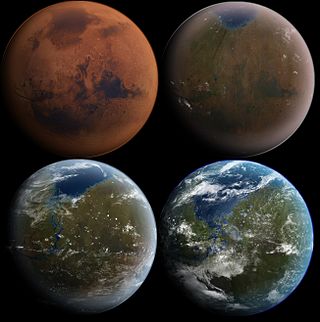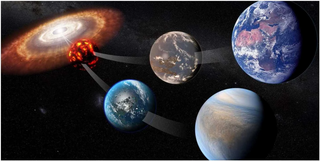
A planet is a large, rounded astronomical body that is neither a star nor its remnant. The best available theory of planet formation is the nebular hypothesis, which posits that an interstellar cloud collapses out of a nebula to create a young protostar orbited by a protoplanetary disk. Planets grow in this disk by the gradual accumulation of material driven by gravity, a process called accretion. The Solar System has at least eight planets: the terrestrial planets Mercury, Venus, Earth, and Mars, and the giant planets Jupiter, Saturn, Uranus, and Neptune.

Terraforming or terraformation ("Earth-shaping") is the hypothetical process of deliberately modifying the atmosphere, temperature, surface topography or ecology of a planet, moon, or other body to be similar to the environment of Earth to make it habitable for humans to live on.

The nebular hypothesis is the most widely accepted model in the field of cosmogony to explain the formation and evolution of the Solar System. It suggests the Solar System is formed from gas and dust orbiting the Sun which clumped up together to form the planets. The theory was developed by Immanuel Kant and published in his Universal Natural History and Theory of the Heavens (1755) and then modified in 1796 by Pierre Laplace. Originally applied to the Solar System, the process of planetary system formation is now thought to be at work throughout the universe. The widely accepted modern variant of the nebular theory is the solar nebular disk model (SNDM) or solar nebular model. It offered explanations for a variety of properties of the Solar System, including the nearly circular and coplanar orbits of the planets, and their motion in the same direction as the Sun's rotation. Some elements of the original nebular theory are echoed in modern theories of planetary formation, but most elements have been superseded.

A protoplanetary disk is a rotating circumstellar disc of dense gas and dust surrounding a young newly formed star, a T Tauri star, or Herbig Ae/Be star. The protoplanetary disk may also be considered an accretion disk for the star itself, because gases or other material may be falling from the inner edge of the disk onto the surface of the star. This process should not be confused with the accretion process thought to build up the planets themselves. Externally illuminated photo-evaporating protoplanetary disks are called proplyds.

Hot Jupiters are a class of gas giant exoplanets that are inferred to be physically similar to Jupiter but that have very short orbital periods. The close proximity to their stars and high surface-atmosphere temperatures resulted in their informal name "hot Jupiters".
Planetary engineering is the development and application of technology for the purpose of influencing the environment of a planet. Planetary engineering encompasses a variety of methods such as terraforming, seeding, and geoengineering.

Planetary migration occurs when a planet or other body in orbit around a star interacts with a disk of gas or planetesimals, resulting in the alteration of its orbital parameters, especially its semi-major axis. Planetary migration is the most likely explanation for hot Jupiters. The generally accepted theory of planet formation from a protoplanetary disk predicts that such planets cannot form so close to their stars, as there is insufficient mass at such small radii and the temperature is too high to allow the formation of rocky or icy planetesimals.

Planetary habitability is the measure of a planet's or a natural satellite's potential to develop and maintain environments hospitable to life. Life may be generated directly on a planet or satellite endogenously or be transferred to it from another body, through a hypothetical process known as panspermia. Environments do not need to contain life to be considered habitable nor are accepted habitable zones (HZ) the only areas in which life might arise.
Terraforming is well represented in contemporary literature, usually in the form of science fiction, as well as in popular culture. While many stories involving interstellar travel feature planets already suited to habitation by humans and supporting their own indigenous life, some authors prefer to address the unlikeliness of such a concept by instead detailing the means by which humans have converted inhospitable worlds to ones capable of supporting life through artificial means.

The terraforming of Venus or the terraformation of Venus is the hypothetical process of engineering the global environment of the planet Venus in order to make it suitable for human habitation. Adjustments to the existing environment of Venus to support human life would require at least three major changes to the planet's atmosphere:
- Reducing Venus's surface temperature of 737 K
- Eliminating most of the planet's dense 9.2 MPa (91 atm) carbon dioxide and sulfur dioxide atmosphere via removal or conversion to some other form
- The addition of breathable oxygen to the atmosphere.
The ethics of terraforming has constituted a philosophical debate within biology, ecology, and environmental ethics as to whether terraforming other worlds is an ethical endeavor.

There is evidence that the formation of the Solar System began about 4.6 billion years ago with the gravitational collapse of a small part of a giant molecular cloud. Most of the collapsing mass collected in the center, forming the Sun, while the rest flattened into a protoplanetary disk out of which the planets, moons, asteroids, and other small Solar System bodies formed.

The Nicemodel is a scenario for the dynamical evolution of the Solar System. It is named for the location of the Côte d'Azur Observatory—where it was initially developed in 2005—in Nice, France. It proposes the migration of the giant planets from an initial compact configuration into their present positions, long after the dissipation of the initial protoplanetary disk. In this way, it differs from earlier models of the Solar System's formation. This planetary migration is used in dynamical simulations of the Solar System to explain historical events including the Late Heavy Bombardment of the inner Solar System, the formation of the Oort cloud, and the existence of populations of small Solar System bodies such as the Kuiper belt, the Neptune and Jupiter trojans, and the numerous resonant trans-Neptunian objects dominated by Neptune.

An Earth analog, also called an Earth analogue, Earth twin, or second Earth, is a planet or moon with environmental conditions similar to those found on Earth. The term Earth-like planet is also used, but this term may refer to any terrestrial planet.

The Late Heavy Bombardment (LHB), or lunar cataclysm, is a hypothesized astronomical event thought to have occurred approximately 4.1 to 3.8 billion years (Ga) ago, at a time corresponding to the Neohadean and Eoarchean eras on Earth. According to the hypothesis, during this interval, a disproportionately large number of asteroids and comets collided into the terrestrial planets and their natural satellites of the inner Solar System, including Mercury, Venus, Earth and Mars. These came from both post-accretion and planetary instability-driven populations of impactors. Although it used to be widely accepted, it remained difficult to provide an overwhelming amount of evidence for the hypothesis. However, recent re-appraisal of the cosmo-chemical constraints indicates that there was likely no late spike in the bombardment rate.
The five-planet Nice model is a numerical model of the early Solar System that is a revised variation of the Nice model. It begins with five giant planets, the four that exist today plus an additional ice giant between Saturn and Uranus in a chain of mean-motion resonances.

Planetary science is the scientific study of planets, celestial bodies and planetary systems and the processes of their formation. It studies objects ranging in size from micrometeoroids to gas giants, aiming to determine their composition, dynamics, formation, interrelations and history. It is a strongly interdisciplinary field, which originally grew from astronomy and Earth science, and now incorporates many disciplines, including planetary geology, cosmochemistry, atmospheric science, physics, oceanography, hydrology, theoretical planetary science, glaciology, and exoplanetology. Allied disciplines include space physics, when concerned with the effects of the Sun on the bodies of the Solar System, and astrobiology.
The jumping-Jupiter scenario specifies an evolution of giant-planet migration described by the Nice model, in which an ice giant is scattered inward by Saturn and outward by Jupiter, causing their semi-major axes to jump, and thereby quickly separating their orbits. The jumping-Jupiter scenario was proposed by Ramon Brasser, Alessandro Morbidelli, Rodney Gomes, Kleomenis Tsiganis, and Harold Levison after their studies revealed that the smooth divergent migration of Jupiter and Saturn resulted in an inner Solar System significantly different from the current Solar System. During this migration secular resonances swept through the inner Solar System exciting the orbits of the terrestrial planets and the asteroids, leaving the planets' orbits too eccentric, and the asteroid belt with too many high-inclination objects. The jumps in the semi-major axes of Jupiter and Saturn described in the jumping-Jupiter scenario can allow these resonances to quickly cross the inner Solar System without altering orbits excessively, although the terrestrial planets remain sensitive to its passage.

In planetary astronomy, the grand tack hypothesis proposes that Jupiter formed at a distance of 3.5 AU from the Sun, then migrated inward to 1.5 AU, before reversing course due to capturing Saturn in an orbital resonance, eventually halting near its current orbit at 5.2 AU. The reversal of Jupiter's planetary migration is likened to the path of a sailboat changing directions (tacking) as it travels against the wind.

Pebble accretion is the accumulation of particles, ranging from centimeters up to meters in diameter, into planetesimals in a protoplanetary disk that is enhanced by aerodynamic drag from the gas present in the disk. This drag reduces the relative velocity of pebbles as they pass by larger bodies, preventing some from escaping the body's gravity. These pebbles are then accreted by the body after spiraling or settling toward its surface. This process increases the cross section over which the large bodies can accrete material, accelerating their growth. The rapid growth of the planetesimals via pebble accretion allows for the formation of giant planet cores in the outer Solar System before the dispersal of the gas disk. A reduction in the size of pebbles as they lose water ice after crossing the ice line and a declining density of gas with distance from the sun slow the rates of pebble accretion in the inner Solar System resulting in smaller terrestrial planets, a small mass of Mars and a low mass asteroid belt.













